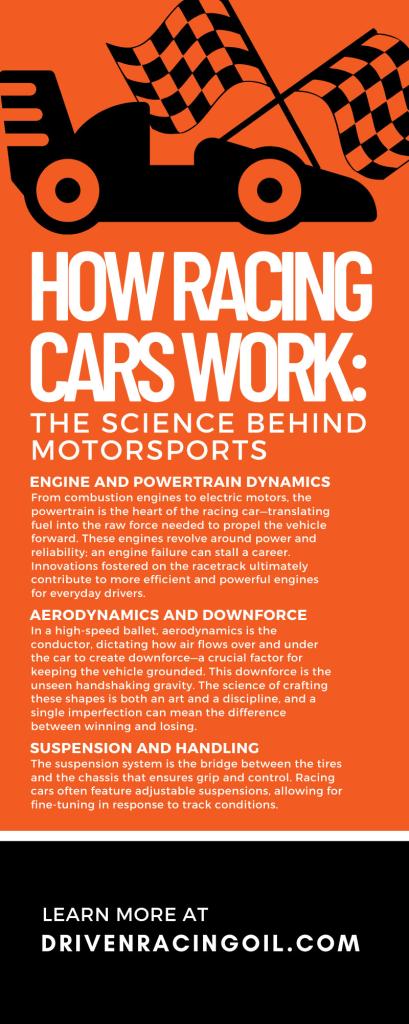How Racing Cars Work: The Science Behind Motorsports

When it comes to the thrill of speed and the pursuit of mechanical excellence, few arenas are as captivating as the world of motorsports. Racing cars aren’t just marvels of engineering—they’re the vanguards of technology, pushing the boundaries of what’s possible on the track and, crucially, what we’ll find in our future vehicles. Here, we’ll rev the engines of curiosity and dive into the intricate inner workings of these high-octane machines, aiming for the checkered flag of a comprehensive understanding of motorsports. Read on to explore how racing cars work and learn about the science behind motorsports.
The Mechanics of Motion
The car’s mechanics are the powerhouse, helping keep record time when making stops in the pit and resurging to make it through all laps without fail. Every millisecond counts in and out of the pit, so to fully understand a racer’s motion requires one to understand the vehicle’s mechanics.
What goes on in the beating heart of a car? It’s the powertrain design, aerodynamic principles, and precision engineering. Understanding the intricate symphony of parts in a racing car is like uncovering the secrets of a high-performance orchestra.
Engine and Powertrain Dynamics
From combustion engines to electric motors, the powertrain is the heart of the racing car—translating fuel into the raw force needed to propel the vehicle forward. These engines revolve around power and reliability; an engine failure can stall a career. Innovations fostered on the racetrack ultimately contribute to more efficient and powerful engines for everyday drivers.
Aerodynamics and Downforce
In a high-speed ballet, aerodynamics is the conductor, dictating how air flows over and under the car to create downforce—a crucial factor for keeping the vehicle grounded. This downforce is the unseen handshaking gravity. The science of crafting these shapes is both an art and a discipline, and a single imperfection can mean the difference between winning and losing.
Suspension and Handling
The suspension system is the bridge between the tires and the chassis that ensures grip and control. Racing cars often feature adjustable suspensions, allowing for fine-tuning in response to track conditions. This nimble handling is what separates the cream from the pack, laying the groundwork for those heart-stopping moments when a driver maneuvers around his next contender. Think of Max Verstappen as a point of reference.
Innovative Technology on the Asphalt
Modern motorsports have some of the best cutting-edge technology. It’s not just about going fast; it’s about going smart. Today’s engineers factor in digital technology and environmental concerns, spinning the sport on an entirely new axis.
Data Telemetry and Analysis
Monitors record and dissect every twist, turn, and surge of the accelerator. Data telemetry provides real-time feedback to teams, highlighting a car’s performance and possible areas for improvement. Telemetry systems are so advanced that it doesn’t take engineers long to spot a problem before the driver feels it. These moments allow them to perform protective adjustments before sending the driver off, determining the difference between standing on the podium or in the pits.
Materials and Construction
How do tire manufacturers making products for professional racecars find the best wheel materials? They determine the best suit on strength-to-weight ratios. The best designs strike a balance between sturdiness and lightness, as any extra gram is one the engine must hurl down the track. These materials, combined with groundbreaking manufacturing processes, yield racing cars that are fast, agile, and durable enough to withstand the extreme rigors of the race.
The Human Element in the Fast Lane
Behind every racing car is an ensemble of human talent (think of professionals from teams such as Formula 1 and NASCAR). Drivers are the face of the sport, and their finesse behind the wheel is a captivating dance with danger that requires both skill and an intimate understanding of the machine.
Driver Skills and Techniques
In the cockpit, a driver is not just a pilot but an expert tactician. Acceleration, braking, and cornering come together in an intricate choreography of footwork and hand-eye coordination executed with the precision of a surgical procedure. This artful control at high speeds separates legends from the merely proficient.
Pit Stops and Strategy
The people that keep the process going are the teams in the pit. These engineers tirelessly turn tires, load fuel, and make minor repairs in milliseconds. But technology and teamwork aren’t all they do. Mechanical engineering teams attach cameras, take photos, and record moments when accidents occur. From those small moments, teams can prepare and strategize how to get a car up and running again.
Team Dynamics and Collaboration
No one wins a race alone. Each racer has a team of mechanics and engineers working together to fine-tune the car for the best possible performance. Communication, trust, and a shared passion forge bonds among team members.
Where Performance Meets Safety
Safety cannot go to the shadows in a domain where speed is king. Motorsports have a history of pushing the envelope in driver protection and accident prevention with innovative safety features that often make their way into production vehicles.
Speed and Performance Metrics
Speed isn’t just about one number. Lap times, top speeds, and g-forces are the benchmarks that measure performance, and they form a lexicon shared by enthusiasts and experts alike. They’re the raw data that fuel debates and determine pecking orders on the track.
Safety Innovations and Regulations
When on the quest for speed, drivers mustn’t overlook safety. Innovations such as the HANS device, crumple zones, and high-tech fire-retardant suits are testimony to motorsports’ commitment to driver safety. With every accident and near-miss, the sport revisits its safety protocols, drafting new regulations and pushing manufacturers to implement more robust protective measures.
Driver Protection and Crash Management
The thrill of the crash is the specter that haunts every race and warrants meticulous review. Survival cell design, energy-absorbing barriers, and medical intervention systems are just a few of the enhancements that stand guard, ready to spring into action when the worst confronts the best.
The Finish Line of Understanding
At the finish line, we reflect on the real purpose behind motorsports, going beyond a contest of speed. These races are a confluence of technology, team effort, and human spirit, a living testament to our desire to go faster and refine the processes that get us there. The science behind racing cars is an arc that bends towards innovation, both on and off the track.
In appreciation of the sport’s tireless pursuit of excellence, it’s only fitting that we refine our approach to our most cherished machines. Choosing the right tools to maintain our vehicles is not an easy choice, as each decision revolves around specific criteria.
The engine that moves our cars is a finely tuned instrument that deserves the best. That’s why settling for anything less than top-tier is not an option when it comes to the racing motor oil that protects your engine. When protecting your ride’s performance, think of Driven Racing Oil. Our oils are the lifeline of your motors, ensuring they go fast and don’t stay in the pit for too long.


You must login to post comments.